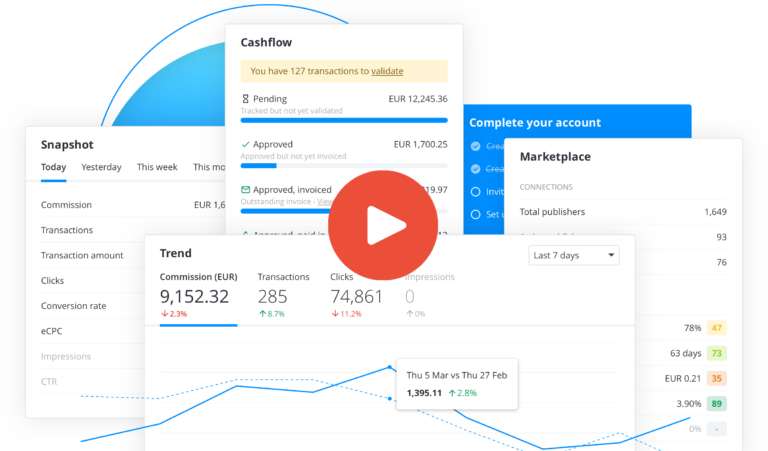
How to become an affiliate from scratch
Financial independence. Who wouldn’t like that? Well, becoming an affiliate might just be the way to go. Read our how-to and get started! … Read More

Share this post
Affiliate marketing, you’ve probably heard about it before. You might even consider starting with affiliate marketing. Which isn’t strange, affiliate marketing is trending. The pay-per-performance basis on which affiliate marketing is based is very tempting for companies right now.
They don’t have to invest in big marketing campaigns, but only payout when one of their affiliates makes a sale. In this article, we clearly explain what affiliate marketing is. So if you’re curious about affiliate marketing, but not experienced in it, this article is for you.
The basics of affiliate marketing is that you earn a commission every time you make a sale by promoting someone else’s products or services. Or that you pay a commission every time someone makes a sale on your products or services. Important to note is, no sale means no pay.
With affiliate marketing, the branding and marketing of products and services are spread out between different parties. This allows a brand to utilize the talents of individual publishers in their marketing while providing these individuals with a share of the profit. To make affiliate marketing work, three parties need to be involved.
The advertiser is the owner of the product or service that is going to be sold through affiliate marketing. This can be a large enterprise or a solo entrepreneur. The product or service can be anything, from kitchen utensils to magazine subscriptions or online classes.
The advertiser sells his product or service through the affiliates. Affiliate marketing can be his only marketing tool, but mostly they also use more traditional marketing tools, like advertising. When someone sells a product or service for the advertiser, the advertiser gets paid. In turn, the advertiser then pays a commission to the affiliate who made the sale.
The affiliate marketer, or publisher, is the person (or sometimes company) that markets the advertisers’ products or services to potential customers. They will receive a fee for promoting the goods through their own network and online presence. For every sale they make, the advertiser pays them a commission.
Let’s say a certain affiliate marketer has an Instagram account with 100.000 followers, on that Instagram she mainly talks about beauty products. It’s interesting for companies who sell beauty products to work with her. So beauty company X asks her to promote beauty product Y. This fits her profile, so she accepts. She then uses her Instagram account to talk about product Y to her fans, who are interested in beauty products. Sometimes the affiliates get a discount code they can use. Every time a follower of her buys beauty product Y, beauty company X pays her the fee they agreed on.
The advertiser gets more sales, and the affiliate gets paid a fee. That’s the beauty of affiliate marketing, it’s a win-win.
The consumers may not be aware of it, but they are the driving force behind affiliate marketing. Without consumers, there’s no audience to share the products with.
When the consumer buys a service or product via the affiliate, the affiliate and the advertiser share the profit. A lot of affiliates these days choose to share that they are affiliate marketers. You may have seen this via social media posts that say #affiliate, #partnership, or #ad. Some publishers do not disclose that they are an affiliate marketer, in which case the consumer doesn’t know that their purchase is part of an affiliate marketing program.
Whatever the case, consumers rarely pay more for products and services purchased through affiliate marketing. The affiliate marketers share of the profit is already included in the retail price. Some affiliates even get to give out discount codes, in which case the consumer pays less for the product or service when bought through affiliate marketing.
Affiliates always look at one another to find the best ways to engage their audience and persuade them into making a purchase. Not all affiliate marketers use the same channels to do so. These are the most common marketing channels used by affiliate marketers.
A good blogger ranks good in Google and ranking good in Google means reaching a lot of potential customers. Often, the bloggers sample the advertisers product or service and write an extensive review that promotes the brand in a captivating way. This persuades the readers of the blog to make a purchase. The blogger is then rewarded for every sale his blog produces.
Cashback websites are websites that facilitate the cashback a consumer can get after making a purchase. How does this work? The cashback website is an affiliate partner of the webshops they offer cashbacks for, when a consumer makes a purchase through the cashback site, the cashback site receives a commission. The cashback sites then pays a part of their commission back to that consumer. Basically, the cashback website shares his commission with the consumer, which is how the cashbacks are paid for. There are even cashback websites that offer 100% of their commision as cashback.
A so-called influencer is someone with a large group of online followers which they can ‘influence’. An influencer is in a great position to become an affiliate. They already have a large following, so it’s relatively easy for them to steer consumers towards the advertisers’ products or services. They can use their social media page, blog or website to do so. Reaching an audience is one of the hardest parts of affiliate marketing, and an influencer already has that audience.
Affiliate marketing is very tempting for anyone looking to increase their online income. It’s often seen as a quick and inexpensive way to make money online, because you don’t actually have to own a product or service. It’s not as easy as one might dream, you do need to draw a lot of attention to the product or services of the advertiser. A large online following is pretty much required to make a lot of money in affiliate marketing.
The affiliate gets paid for every action a consumer does. Let’s talk about the most common ways for an affiliate marketer to get paid.
The pay per sale, or PPS, structure is the industry standard. Every time the affiliate makes a sale, the advertiser pays them a percentage of the sale price. This percentage is different for every product but is often set around 10% of the sale price. For every $100,- sale, the affiliate receives $10,- and the advertiser receives $90,-.
This payment method is mostly preferred by advertisers because they only have to pay money when an affiliate actually makes a sale. The no cure no pay method makes it the safest option for the advertiser.
The pay per lead, or PPL, structure is less common because a lead doesn’t necessarily mean revenue for the advertiser. In this structure, the affiliate gets paid for every lead they generate for the advertiser. A lead is someone that visits the advertisers’ website and performs a certain action, like signing up for a newsletter, a free trial, or filling out a contact form. This structure is used when the advertiser has a goal other than sales, like receiving email addresses to send their newsletters to.
Because the pay per lead structure doesn’t lead to direct sales, the commission for the affiliate is often lower than it is with pay per sale.

Related articles

Financial independence. Who wouldn’t like that? Well, becoming an affiliate might just be the way to go. Read our how-to and get started! … Read More

There are a lot of different types of publishers. We’ve listed 9 common types of publishers and how to successfully work with them. … Read More

Curious to learn more about the most used terms in affiliate marketing? We’ve listed all the terms you’ll come across on a daily basis! … Read More

Read this checklist to make your affiliate program a great success … Read More

Are you curious to start with affiliate marketing? We’ve written out the basics! … Read More
Share this post
Recent posts
Follow us
Subscribe to our newsletter
By subscribing to our newsletter